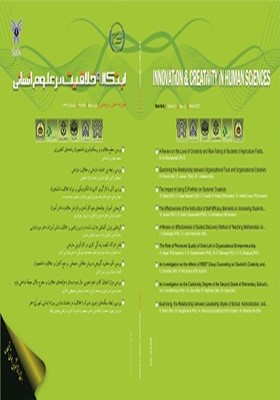بررسی سطح خلاقیت و ریسکپذیری دانشجویان رشتههای کشاورزی
محورهای موضوعی : خلاقیت و نوآوری از جنبه‏های روان‏شناختی، علوم شناختی، علوم تربیتی و آموزشی (خلاقیت شناسی روان‏شناختی، خلاقیت شناسی پرورشی)
1 - دکتری علوم تربیتی،کارآفرینی،دانشگاه علوم کشاورزی و منابع طبیعی ساری.
mehdy1352@yahoo.com
کلید واژه: خلاقیت, ریسک پذیری, دانشجویان کشاورزی,
چکیده مقاله :
زمینه: امروزه، دیگر نقش و اهمیت خلاقیت و ریسک پذیری به عنوان عاملی مؤثر در کارآفرینی بر کسی پوشیده نیست و با توجه به جایگاه آموزش عالی و نقش بخش کشاورزی در استقلال ملتها، بررسی این شاخصها برای برنامه ریزیهای آتی مهم به شمار میرود. هدف: این پژوهش به منظور بررسی سطح خلاقیت و ریسک پذیری در دانشجویان رشتههای کشاورزی انجام گرفته است. روش: جامعه آماری پژوهش، شامل کلیه دانشجویان کارشناسی دانشگاه علوم کشاورزی و منابع طبیعی ساری بود (2340 N=) که تعداد 379 نفر از آنها به روش نمونه گیری تصادفی،انتخاب شدند. ابزار این پژوهش، پرسشنامه تهیه شده توسط اسداله کردنائیج و همکاران بوده که روایی آن توسط طراحان پرسشنامه و پایایی آن با استفاده از ضریب آلفای کرونباخ (92/0= α) تأیید شد. تجزیه و تحلیل دادهها نیز در دو بخش توصیفی و تحلیل، با استفاده از نرم افزار اس پی اس اس[1] انجام گردید. یافتهها: دانشجویان مورد مطالعه، در ویژگی ریسک پذیری و خلاقیت ضعف جدی دارند. بین پسر ها و دختر های دانشجو، در ویژگی خلاقیت اختلاف معناداری وجود ندارد، اما ویژگی ریسک پذیری دختران بالاتر از پسران بوده و بین آنها اختلاف معنا داری وجود دارد و بین دانشجویان رشتههای مورد مطالعه، از نظر ویژگی ریسک پذیری اختلاف معناداری مشاهده نمیگردد. در ویژگی خلاقیت، دانشجویان رشته مرتع داری،به جز زراعت، با بقیه رشتهها اختلاف دارند و دانشجویان رشته زراعت نیز با رشتههای مرتع داری، خاکشناسی و صنایع غذایی اختلاف نداشته ولی با بقیه رشتهها اختلاف دارند. نتیجه گیری: با توجه به نتایج پژوهش مبنی بر پایین بودن سطح برخورداری دانشجویان مورد مطالعه از خصایص کارآفرینی مورد نظر و وجود اختلاف بین برخی رشتهها و نیز مشخص بودن اثر آموزش و پرورش بر تقویت خصایص کارآفرینانه، بازنگری و برنامه ریزیهای جدی و نوین آموزشی ضروری است. [1]. Spss
Background: Nowadays, the importance of creativity and risk-taking entrepreneurship is crystal bright.Given the importance of higher education and the role of agriculture on the national independence, reviewing the indicators of these concepts is considered to be rather important for planning. Purpose: This study is designed to review the degree of creativity and risk-taking in students of agriculture fields. Method: The study population consisted of all undergraduate students of Sari University of Agricultural Sciences and Natural Resources (2340 = N), of whom 379 were randomly selected. The research instrument was a questionnaire prepared by A. Korrdnaij. et al, while its validity and reliability of questionnaire design by using Cronbach's alpha coefficient (α = 0/92) was confirmed. Data analysis was carried out in two parts: a description and analysis was performed using the SPSS software. Results: Students have notable weaknesses in risk-taking and creativity. Between boys and girls, there is no significant difference on students' creativity. But risk-taking characteristics in girls is higher than boys, and there are significant differences between them. Between students in terms of features, there is no significant difference in, risk-taking. But in creativity feature, Rangeland students except Agronomy s student have significant differences comparing to the other fields. Further, there are no differences between agronomy students, Rangeland science students, soil science students, and food science and technology students. But there is difference between agronomy students and the other fields. Conclusion: According to research findings students have low levels of entrepreneurial characteristics with differences among some fields, while studying the effects of education on entrepreneurial character's strength and proper planning and employing new training methods is found to be necessary.


